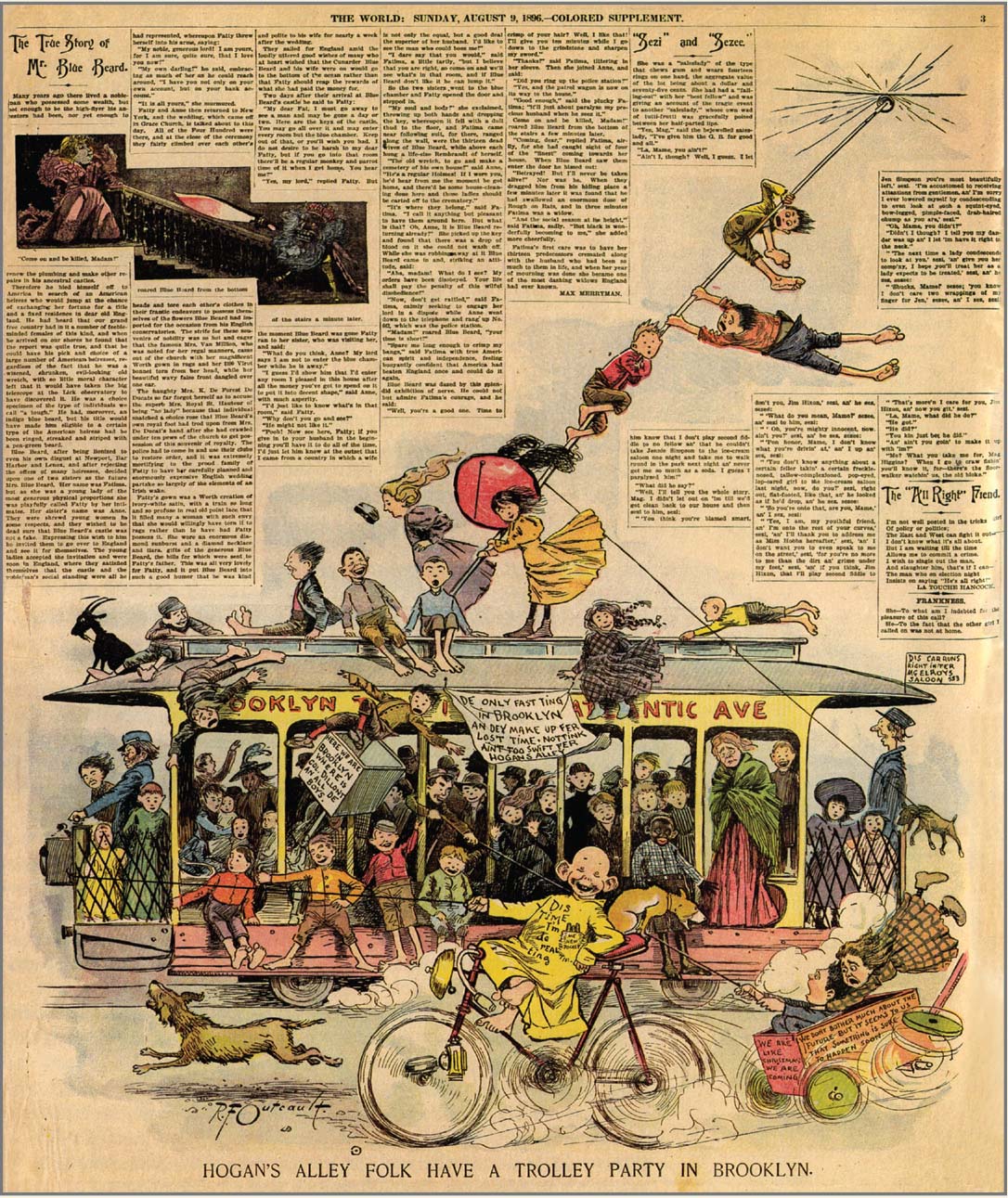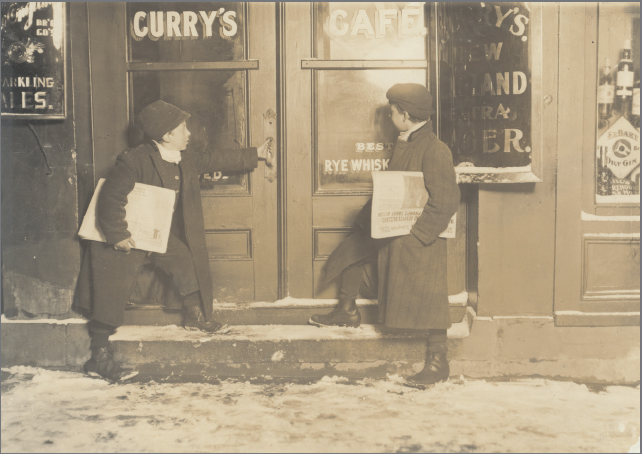America’s History: Printed Page 620
THINKING LIKE A HISTORIAN |  |
Making Mass Media: Newspaper Empires
Among the businesses that served urban consumers were mass-market newspapers. Joseph Pulitzer’s New York World led the way in the 1880s; a decade later Pulitzer had a powerful rival in the New York Journal, owned by William Randolph Hearst.
R. F. Outcault’s “The Yellow Kid” comic, The World, August 9, 1896. Pulitzer and Hearst introduced Sunday color comics, including “The Yellow Kid” (shown here on a bicycle). Working-class readers instantly recognized the “kid,” slang that then referred to working-class immigrant children. The Kid, like other boys of his age, wore skirts; tenement toddlers’ heads were shaved to discourage lice.
 The World, Sunday, August 9, 1896.
The World, Sunday, August 9, 1896.Editorial, Wheeling Register, April 6, 1885. A West Virginia newspaper commented on a campaign by the New York World to complete the Statue of Liberty. Parts of the statue, donated by France, were languishing in New York City parks.
The New York World is a liberty-loving journal. It has taken the responsibility of being foster mother to that much abused piece of bronze called the “BARTHOLDI statue.” It begins to look as if the World may nurse it to a successful termination by raising funds enough through public contributions to complete the pedestal upon which it is to stand. Success to the enterprise.
“HOMELESS, HOPELESS! Nellie Bly in a Night Haunt of the City’s Wretchedest of Women,” New York World, February 9, 1896. Pulitzer and Hearst hired many “stunt reporters.” The most famous was Elizabeth Jane Cochrane, who took her pen name, Nellie Bly, from a popular song. In 1892, sponsored by the World, Bly beat the record in Jules Verne’s famous novel Around the World in Eighty Days, circumnavigating the world in seventy-two days. She filed many investigative pieces such as this one.
An old woman stood with her back against the side of a building. Over her head was a ragged shawl that had once been red. Around her knees hung a limp and shapeless calico skirt. The rain and sleet were falling steadily and lay thick and slushy upon the streets.
I shivered as I stopped to watch. … If the old woman felt the cold she gave no sign. She stood motionless, peeping around the corner. Her eyes were fixed upon the door of the Oak Street Station-House.
Just then three small boys, unmindful of the weather, came trudging down the street …industriously gathering every white spot that showed upon the pavement to add to the black snowballs they held in their wet red hands.
Turning the corner suddenly they came upon the old woman. For a second they paused and looked at her and she glared at them. It reminded me of the way dogs behave when they turn a corner and espy a cat. … The old woman started on a frantic hobble across the street, the boys after her. Their black snowballs landed squarely and soakingly against her bent back. … The old woman shouted things as she ran, things that do not sound well and are never by any chance reproduced in print, but they seemed to increase the delight of the fiendish boys. … She could hobble she made for the station-house and the boys pursued her, pelting her.
Lewis Wickes Hine, newsboys selling at a Hartford, Connecticut saloon, 9:30 P.M., March 1909. In addition to subscriptions and sales at newsstands, newspapers sold bundles of one hundred papers to boys and girls, who resold as many as they could. Photographer Lewis Hine’s caption, included below, suggests one strategy for selling papers. Hine, working for the National Child Labor Committee, took many such images.
 Library of Congress.
Library of Congress.A common case of “team work.” The smaller boy …goes into one of the saloons and sells his “last” papers. Then comes out and his brother gives him more. Joseph said, “Drunks are me best customers. … Dey buy me out so I kin go home.” He sells every afternoon and night. Extra late Saturday. At it again at 6 A.M.
Newsboys strike coverage, New York Herald-Tribune, July 25, 1899. As sales plummeted after the War of 1898, Pulitzer and other newspaper titans raised the cost of a newspaper bundle, for children who resold them, from 50 to 60 cents. Newsboys struck. They failed to get the 50-cent price reinstated, but the World and other companies agreed to buy back unsold papers, which they had not done before. Kid Blink, the strike leader, was blind in one eye.
The newsboys’ strike gathered new strength last night in a monster mass meeting held at New Irving Hall. … “Kid” Blink, who has been made Grand Master Workman of the union, led the procession. … The unbiased spectator last evening could not fail to be impressed with the resolute, manly fight the little fellows are making. …
SPEECH OF “KID” BLINK
…Dis is de time when we’se got to stick togedder like glue! But der’s one ting I want ter say before I goes any furder. I don’t believe in getting’ no feller’s papers frum him and tearin’ ’em up. I know I done it. (Cries of “You bet you did!”) But I’m sorry fer it. No! der ain’t nuttin in dat. We know wot we wants and we’ll git it. … Dem 10 cents is as good ter us as to de millionaires — maybe better. … We’ll strike and restrike till we get it. … We’ll stick togedder like plaster, won’t we, boys?
The boys answered that they would.
Circulation statistics for the New York World from N. W. Ayer and Son’s American Newspaper Annual and Directory, 1910.
Edition Political affiliation No. of Pages Circulation Morning Democratic 16 361,412 Evening Independent 12–16 410,259 Sunday Democratic 56–72 459,663
Sources: (2) Wheeling Register, April 6, 1885; (3) New York World, February 9, 1896; (5) New York Herald-Tribune, July 25, 1899; (6) N. W. Ayer and Son’s American Newspaper Annual and Directory (Philadelphia: N. W. Ayer and Son, 1910), 623.
ANALYZING THE EVIDENCE
Question
Based on these sources, why do you think “yellow journalism” was popular and profitable? What audiences did it serve, and how?
Question
Consider the tone and point of view of sources 1, 3, and 5. What do they suggest about American attitudes toward the urban poor?
Question
What do these sources say about how Pulitzer and Hearst viewed their role as publishers? How might we compare their newspaper empires to other corporations of the industrial era?
PUTTING IT ALL TOGETHER
Question
Write a brief essay in which you explain the ways in which the rise of mass-market newspapers might have contributed to and helped to publicize calls for progressive reform.